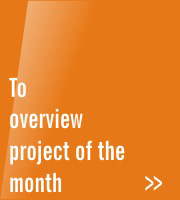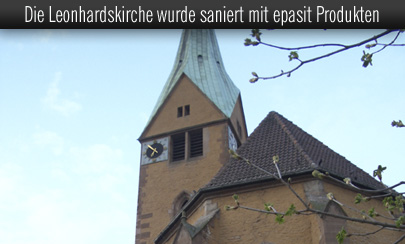|
|
|
"Vesperkirche"
Stuttgart: masonry rehabilitated.

In the heart of Stuttgart, there lies
the Protestant Leonhardskirche. At the socle of the late Gothic
building, a salt contamination occurred that linearly spread inwards.
An extraction seemed to be hopeless and uneconomical. Therefore,
a multiple skin work was necessary which features a particularly
good salt compatibility.
Situation and assignment.

Because of the exposed position of the Leonhardskirche at the center
of the 'red-light and entertainment district' of Stuttgart, the
socle was strongly damaged. The plaster showed spallings, salt efflorescences,
moisture edges and brittle spots. Because the salination reached
deeply into the masonry, the responsible persons decided to rehabilitate
it with a plaster system withstanding the special load.
Preliminary examinations and selection of the material.

Since 2003 the rehabilitation of the Leonhardskirche
has been prepared. Specimens of the Materials Testing Institute
Stuttgart (MPA) showed a high contamination of nitrates (> 1%)
and chlorides (0.4%) mainly in the plaster and also on the surface
of the sandstones. The preliminary examinations and the rehabilitation
work has been coordinated by the restorer Albert Kieferle from AeDis
Hochdorf. Epasit was charged to provide sample surfaces consisting
of leveling plaster and renovation plaster. A competitor created
a sample out of a sacrificial plaster and both surfaces have been
observed over several years. From summer 2008, the rehabilitation
was finally restricted to the socle area for financial reasons.
Rehabilitation with individually
dyed plaster.

The company Colic Stuckrestaurator from Friedrichshafen has been
commissioned to completely remove the existing plaster and to rake
out and dry clean loose joints. Subsequently, the epasit hb Haftspritzbewurf
was applied in a semiopaque way. According to specifications, the
socle was then plastered with an individually reddish dyed lpf-WTA
renovation plaster of a film thickness averaging 30 mm. The plaster
surface will not appear leveled, but uneven like the neighboring
masonry. The plaster has been dyed in order to avoid the appearance
of the differently colored plaster in case of possible damages.
The restorer, Mr Kieferle, justifies the selection of the material
as follows: 'In the total evaluation, besides the good salt compatibility,
above all the colorfulness of the material takes effect, which represented
a very good basis for the dyeing.' Finally, the socle of the church
was coated with a silicone resin color.
Long-term proven rehabilitation system.

The system used for the rehabilitation of moist
masonry affected by salt has been developed by epasit already in
the early seventies and only insignificantly changed since then.
Objects rehabilitated already decades ago are still in a perfect
condition. MineralSanoPro stops disintegration and regulates moisture:
With its high pore volume, a limited absorptive capacity and a good
water vapor permeability, it causes the natural dehydration of the
walls. It fulfills all requirements of the Monument Protection Authority,
and of the DIN EN 998-1 standard and was awarded, as the first renovation
plaster system, the WTA certificate.
Leonhardskirche then and now.

The church built in the 15th century was totally
destroyed in July 1944. At the end of the war, it was reconstructed
as the first of the late gothic churches of Stuttgart and consecrated
already in 1950. For the last 18 years, the Protestant church accomodates
the 'Vesperkirche'. In the social environment of the city it has
been a permanent address where, daily, up to 1,000 persons visit
it. Between January and Palm Sunday people find more than a warm
plate of soup in the Vesperkirche: On offer is food, medical and
veterinary care, rest, conversations, legal advice and vocational
guidance.
|
|

WEITERE OBJEKTE:

Gymnasium zu Bratislava

Burg zu Bratislava

Trinkwasserbehälter
Lindau

Altes Rathaus
Bonn

Stadtgymnasium
Helsinki
 Jugendstilvilla
in Aalen
Jugendstilvilla
in Aalen
 Waldseer
Hof Markdorf
Waldseer
Hof Markdorf
 Therme
Rügen
Therme
Rügen

Schimmelalarm im
Badezimmer

Diakonie-Gebäude
Witten

Leonhardskirche English
>>

Deutscher Kaiser
English
>>

Wilhelma Stuttgart English
>>

Trinkwasserbehälter English
>>

Hafenviertel Tallinn English
>>

EZB Frankfurt English
>>

Zwinger Dresden English
>>
TU-Krakau English
>>

Brunnen
Maulbronn English
>>

Jurahaus English
>>

Sofort-Kontakt

Sie haben Fragen oder wünschen
einen persönlichen Kontakt.
Fon +49 (0)7032
- 20 15-0
Objektbetreuung

Daniel Schlichenmaier

Falls Sie Informationen zur Sanierung
wünschen oder ein ähnliches
Problem haben, steht Ihnen Herr
Schlichenmaier für weitere Informationen gerne zur Verfügung.
Kontakt

e-Mail:
daniel.schlichenmaier@epasit.de
Telefon:
07151-209430
0160-7850481
|


